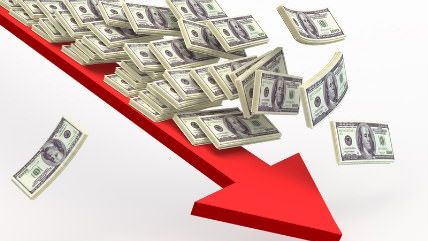Public Employee Pension Funds Prepare for Year of Crappy Returns
Don't worry-you'll make up the difference.


During the big recession, California's pension funds took a pounding, earning just one percent in returns in 2012, by way of example. That is a bit of a problem when the fund promises 7.5 percent returns over the long run to retirees. The pension fund's assets, as a whole, lost a quarter of its value during the financial crisis. Since the pensions are guaranteed, though, the plunge required municipalities and school districts to increase their contributions, thus adding even more to local government financial problems.
The funds bounced back big time last year, with the California Public Employee Retirement System's (CalPERS) returns hitting 18.4 percent. But, the Wall Street Journal notes (full article is paywalled, but can be accessed with a Google news search), the pensions are set to underperform again this year:
The $301 billion pension fund, the largest in the U.S. by assets and known as Calpers, said it earned 2.4% on its investments for the fiscal year ended June 30 because of a slump in the markets and weak private-equity returns. The performance was just shy of its internal goal of 2.5%. It was Calpers' poorest year since 2012, when it earned 1%, and down from 18.4% in 2014.
Calpers is closely watched as a bellwether for how other large pensions across the U.S. will perform, and many of them will report annual results in coming weeks. Pension investments have been challenged this year by low interest rates, uneven market performance and the recovery of the U.S. dollar, which has weakened gains in global stocks.
Many U.S. pensions, including Calpers, don't have enough assets to cover future retirement costs, so investments are critical to close that gap. In some cases, subpar investment results can dial up the pressure on states and cities to force employees to contribute more to retirement plans or cut the benefits retirees are due to receive.
One of the other reasons CalPERS underperforms is because the investment process has been highly politicized, with people calling for investment decisions based not on sound market decisions that will earn the most money, but on rewarding or punishing favored or disfavored options (such disfavored options as investing in guns and tobacco, for example). Why should they care if their social activism is bad business? The returns are guaranteed, so they'll never have to suffer negative consequences for them. Instead, the taxpayers will.
According to The Wall Street Journal, one of the best performers in the pension fund's program was the portfolio for hedge funds, earning two percentage points more than internal targets. But CalPERS announced last year they'd be dumping its hedge fund investments and shifting them to real estate and private equity assets. Their private equity investments underperformed by more than two percentage points, though.
The Wall Street Journal concludes:
A singular dip in performance won't necessarily lead to immediate cost increases for retirement systems, but it does turn up the pressure for better results in the years ahead, said Keith Brainard, research director at the National Association of State Retirement Administrators, an industry group.
"It's a marathon, not a sprint," he said. "Nobody expects stable 7.5% or 8% returns year in, year out."
Expecting that level of return at all is part of the problem though. If taxpayers weren't expected to make up the difference in returns, they could be as cautious or as socially conscientious as they wanted to be.


Show Comments (8)